Other common names:
- Powell amaranth: rough pigweed, amaranth pigweed, green amaranth, green pigweed, careless weed
- Redroot pigweed: rough pigweed, green amaranth, pigweed, wild beet, amaranth pigweed, red root, careless weed, redroot amaranth, common amaranth
- Smooth pigweed: green amaranth, pigweed, wild beet, spleen amaranth, rough pigweed, amaranth pigweed, red amaranth, careless weed, prince’s feather, slender pigweed, smooth amaranthus
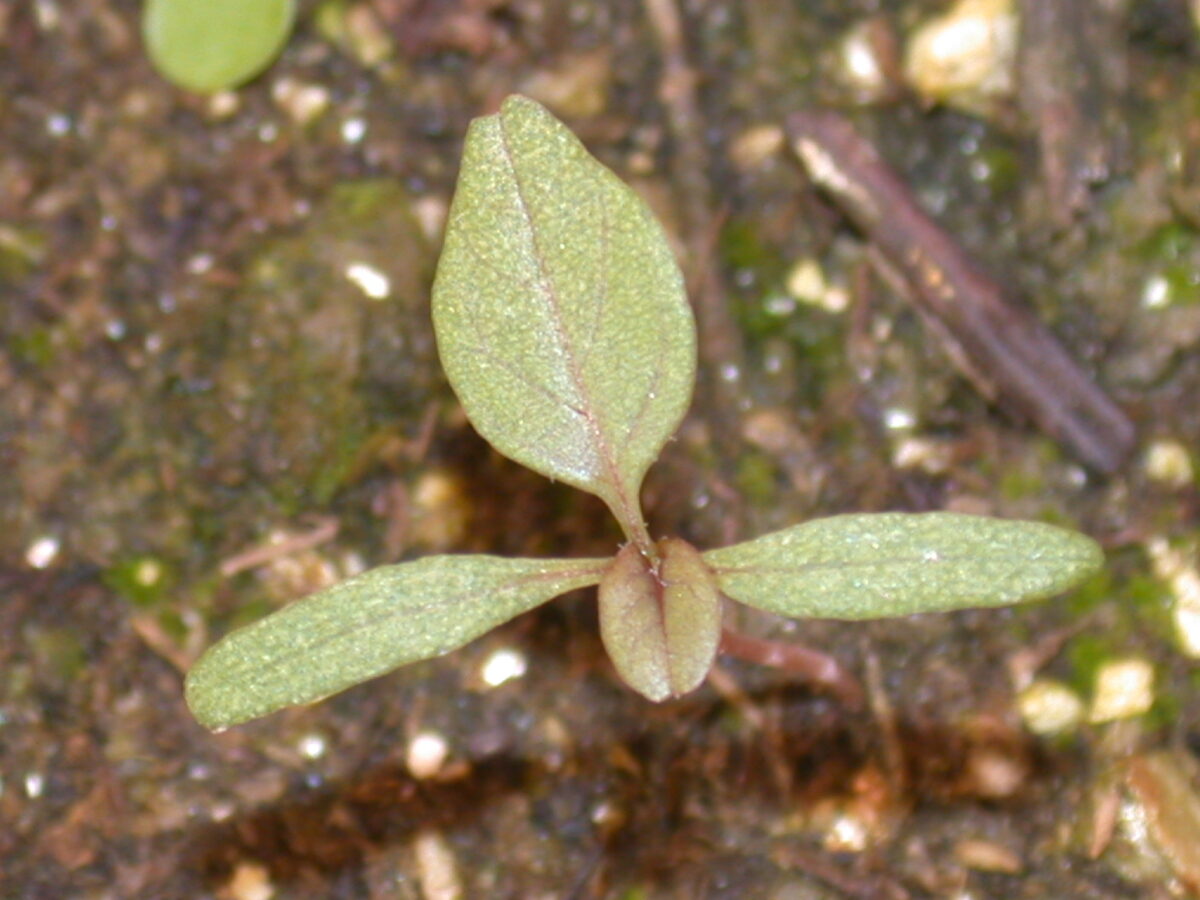
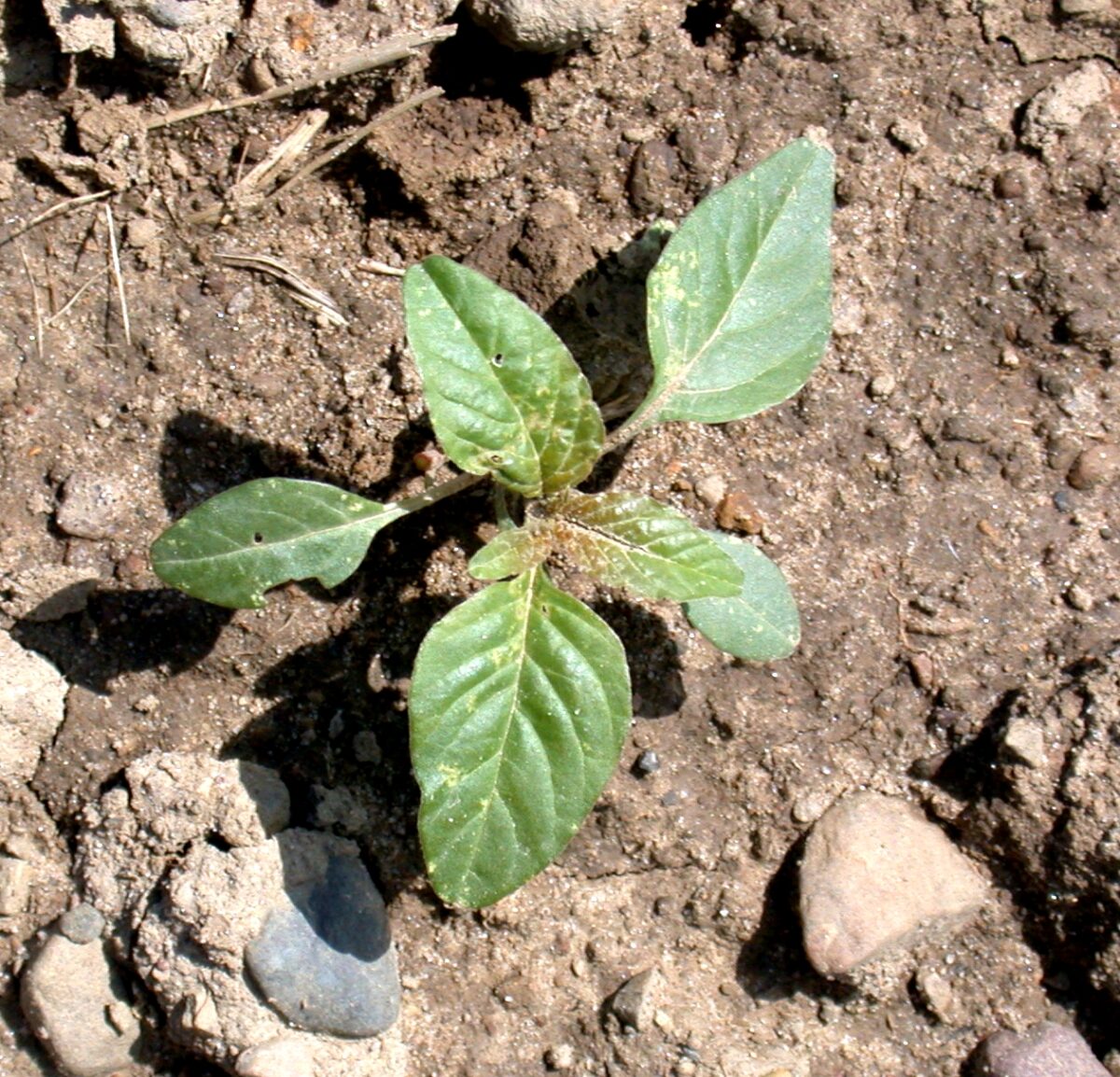
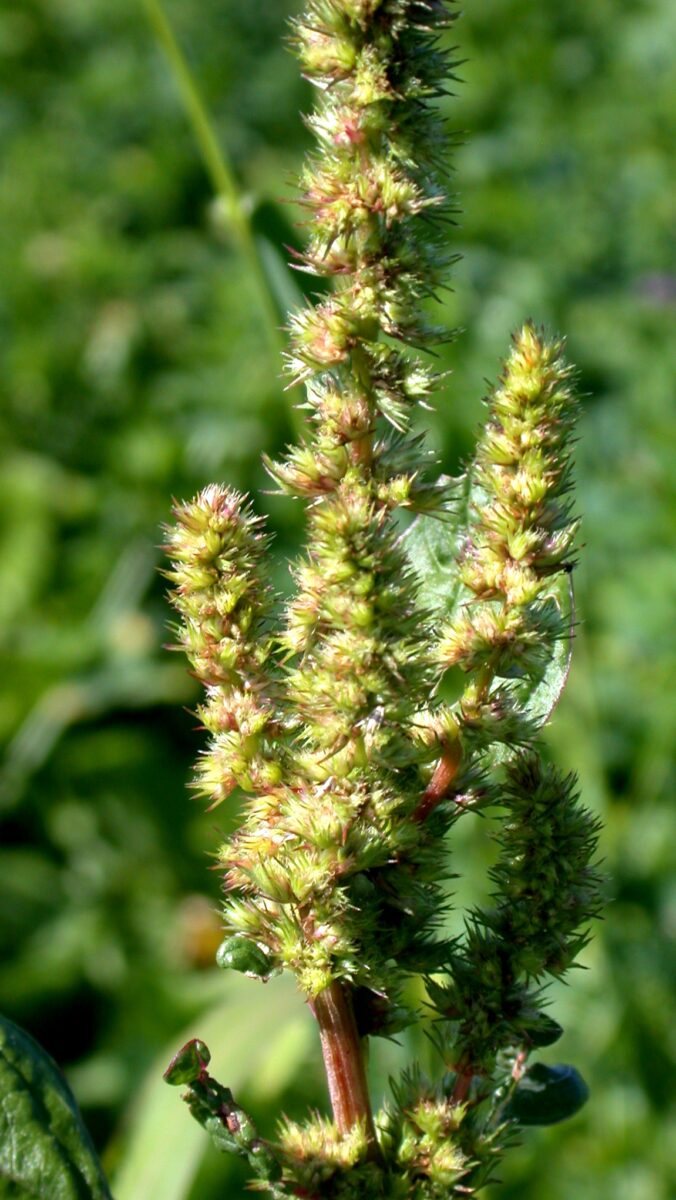
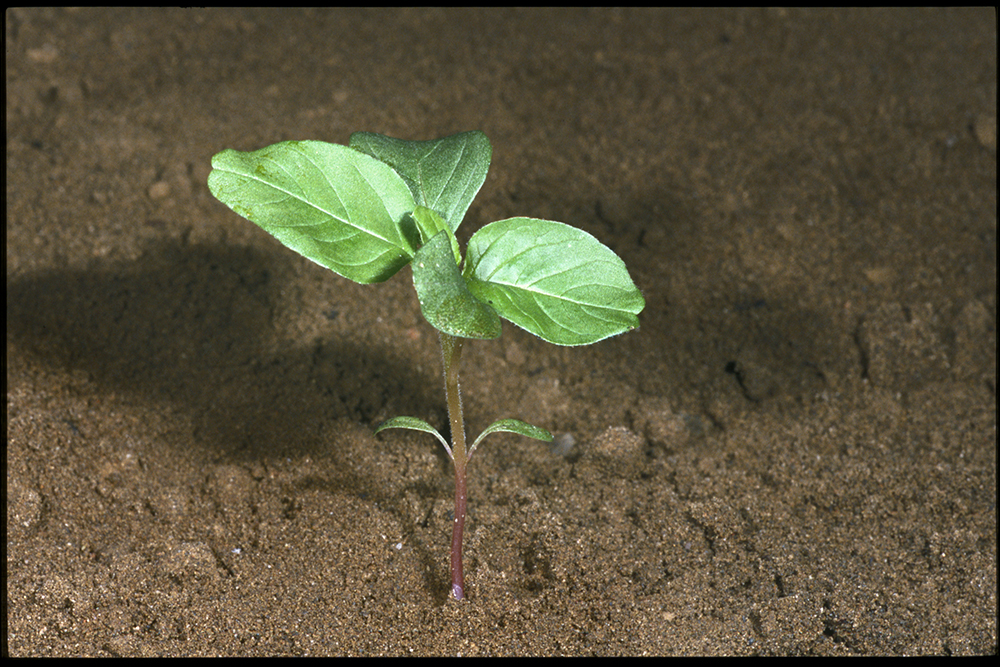
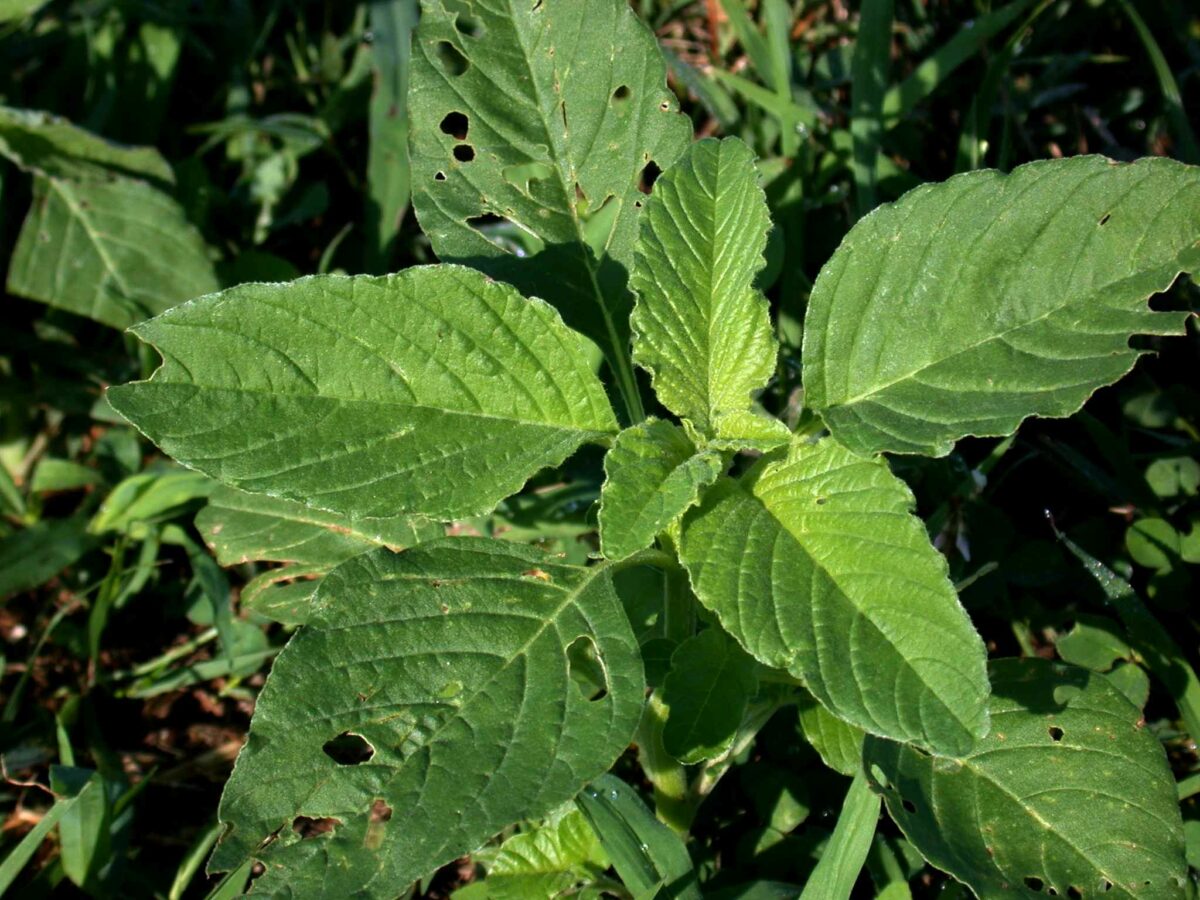
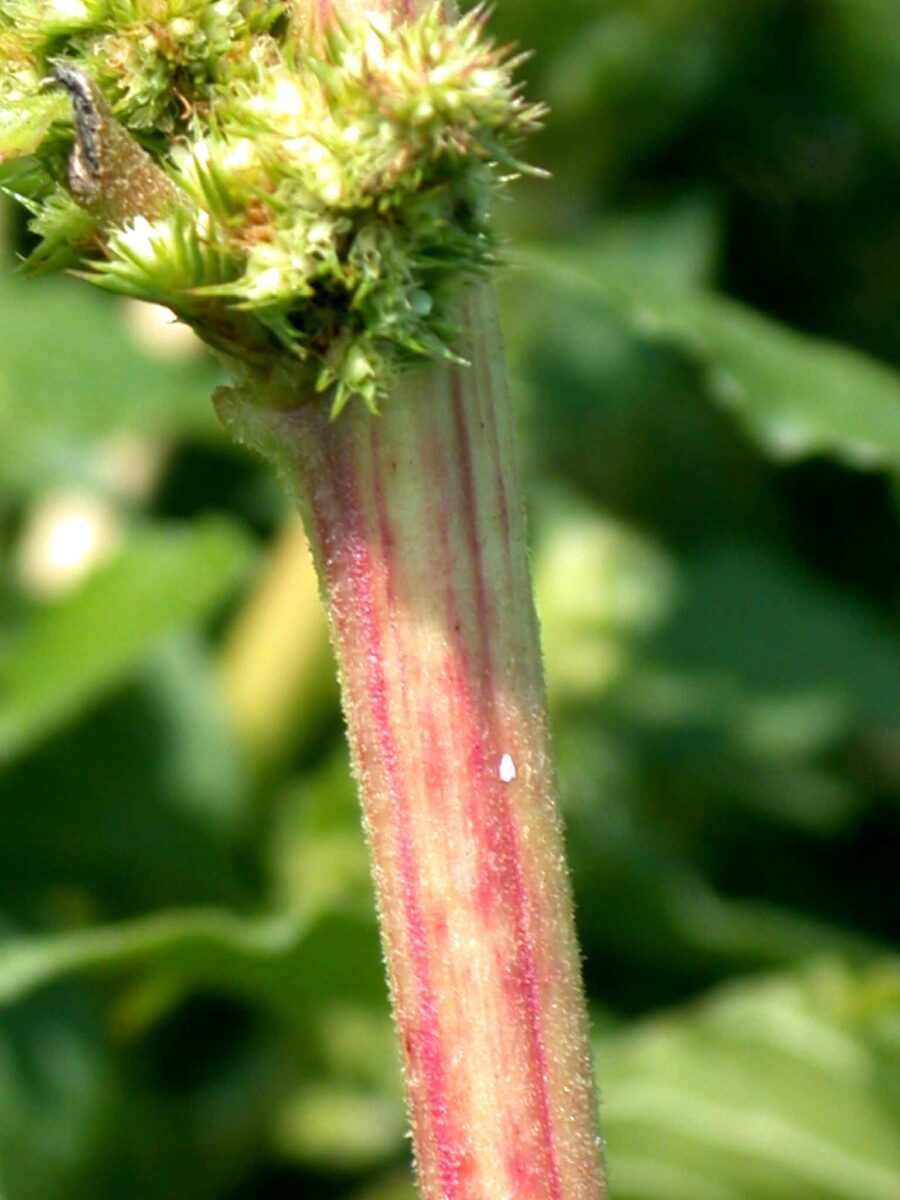
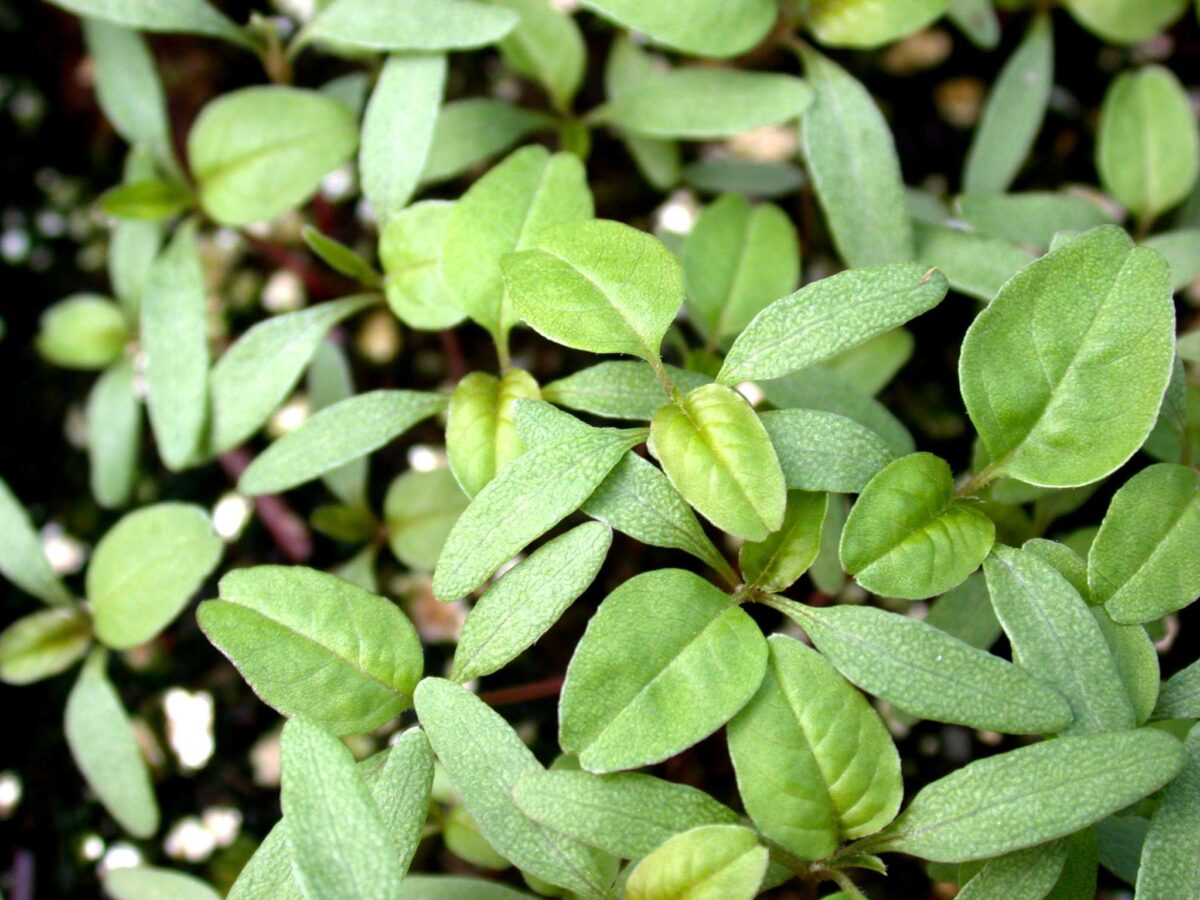
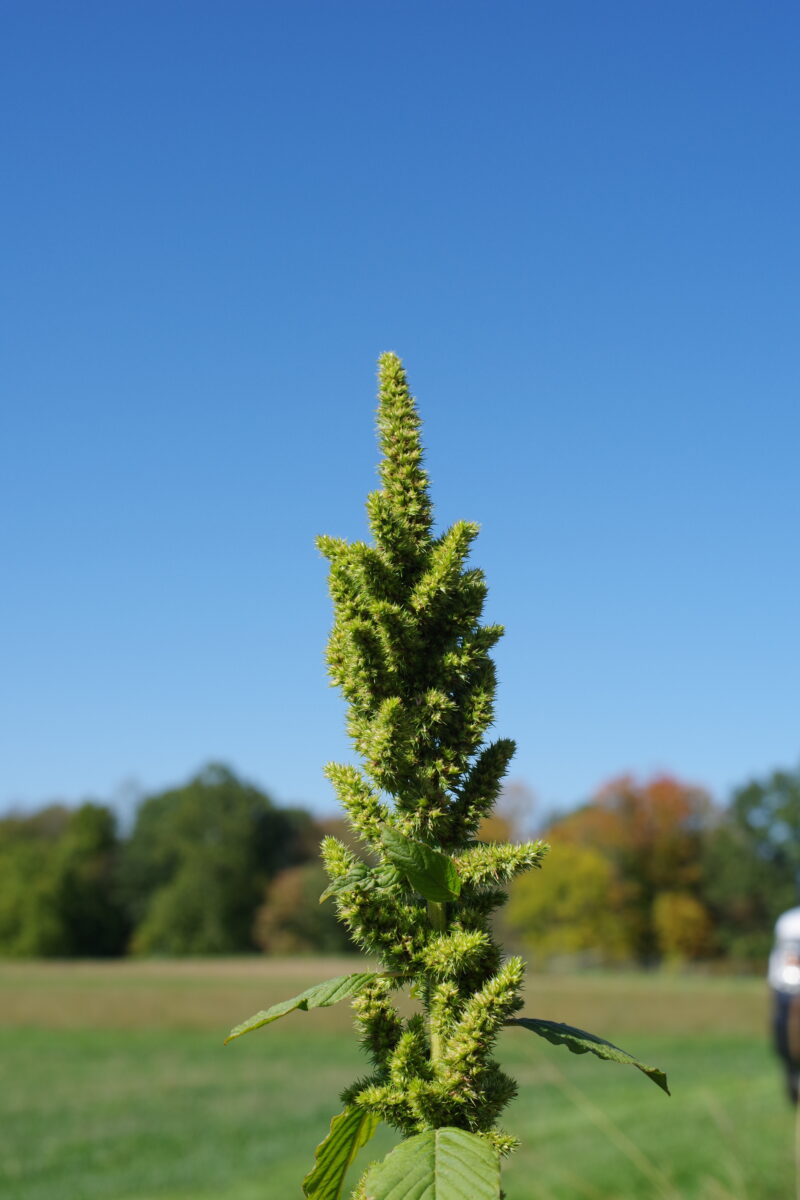
Powell amaranth, Amaranthus powellii S. Watson
Redroot pigweed, Amaranthus retroflexus L.
Smooth pigweed, Amaranthus hybridus L.
Identification of Pigweeds
Family: Amaranth family, Amaranthaceae
Habit: Erect, often branched, summer annual herbs
Description: Seedlings have reddish-pink stem bases and oval shaped true leaves.
Powell amaranth: Stems are nearly hairless and red tinged. Cotyledons are 0.5 inch long and lanceolate, with red or purple undersides. Young leaves are green with red-purple undersides, slightly notched, not wavy along the edges, with a prominent midvein. Very few hairs are present on stems, stalks and leaves.
Redroot pigweed: Stems are hairy and pale green. Cotyledons are 0.5 inch long, lanceolate (four to five times longer than wide) and with red or purple undersides. Young leaves are green, wavy edged and notched with a prominent central vein. A central vein is prominent on the upper surface near the blade base. Small, tough hairs are present on leaf stalks.
Smooth pigweed: Stems are hairy and reddish-purple. Cotyledons are dull green with red-purple undersides, 0.13–0.5 inch long and less than 0.13 inch wide. Young leaves are dark green, slightly wavy-edged and slightly notched with a prominent midvein. Hair is dense on the stems.
Mature plants have a shallow, sometimes red taproot. Leaves are green and alternately arranged.
Powell amaranth: Stems are nearly hairless and can reach 5 feet tall. Leaves are 0.6–3 inches long by 0.2–1.6 inch wide, diamond shaped, pointy tipped, non-ruffled and shiny green (sometimes red-tinged) with white veins on the blade undersides.
Redroot pigweed: Upper stems are coated with curly hairs and can reach 6 feet tall. Leaves are 1.5–6 inches long by 2.5 inches wide, oval to diamond shaped, wavy-edged, and dull green with white central veins on the blade undersides.
Smooth pigweed: Upper stems are coated with short hairs and can reach 6.5 feet tall. Leaves are up to 6 inches long, oval to egg shaped, wavy-edged, long stalked and dark green with strong veins and light green to magenta-tinged undersides.
Flowers are small, greenish (turning brown upon maturity) and clustered into long groups located at branch ends and in leaf-stem joints. Clusters on branch ends are larger than those in leaf axils. Individual flowers are either male or female.
Powell amaranth: Flowers are clustered into thin, stiffly upright, mostly unbranched spikes. Branch end clusters can reach 10 inches long by 0.4–0.8 inch wide.
Redroot pigweed: Flowers are tightly clustered into stiff, branching panicles. Branch end clusters can reach 2–8 inches long by less than 1 inch wide.
Smooth pigweed: Flowers are clustered into nodding, branching spikes. Branch end clusters can reach 6 inches long; those in axils can reach 0.5–3 inches long. Clusters are softer than those of the other species.
Fruit and seeds: Seeds develop singly in small, bladder-like fruits (utricles). Seeds are glossy and dark brown to black, no larger than 0.05 inch, oval to ellipse shaped, flattened and notched at the narrow end.
Powell amaranth: Utricles do not easily rupture. Instead, both seed and sac often fall off the plant as an intact, light tan, 0.1 inch-long unit.
Redroot pigweed: The utricles rupture around the middle, dispersing seeds.
Smooth pigweed: The utricles rupture around the middle, dispersing seeds.
Similar species: Common lambsquarters (Chenopodium album L.) seedlings have opposite, fuzzy or grainy looking, white to pinkish young leaves. Palmer amaranth (Amaranthus palmeri S. Watson) leaves are hairless with white veined undersides and long stalks. It has a soft, 1–1.5 foot-long inflorescence atop its main stem. Waterhemp [Amaranthus tuberculatus (Moq.) Sauer] has tapering, thumb-shaped leaves, long, coarsely branched inflorescences and stems that can reach 8 feet high. Tumble pigweed (Amaranthus albus L.) stems are pale green to white; spiny amaranth (Amaranthus spinosus L.) stems are grooved, hairless and spiny; and prostrate pigweed (Amaranthus blitoides S. Watson) is distinguished by its red, flexible, ground-hugging stems. Livid amaranth (Amaranthus blitum L.) has a matting habit, green to red stems and deeply notched, 1.5 inch-long leaves.
Management of Pigweeds
Pigweed germination is generally responsive to tillage and cultivation after the soil warms. Thus, a one- to two-week lag between initial and final seedbed preparation in late spring or in summer helps flush out and destroy seedlings. The final seedbed preparation should be to a depth of no more than 1.5 inch to avoid raising seeds to near the surface. Tine weed or rotary hoe when seedlings are first emerging. Once the crop is large enough to tolerate inter-row cultivation, hill up slightly (less than 1 inch is usually sufficient) before true leaves of pigweed seedlings appear. Even crops like cabbage and squash that are not normally hilled will tolerate this amount of soil against the base. When growing a crop that tolerates heavy hilling, like corn or potatoes, pile the soil up as high as possible to kill any remaining seedlings at later cultivations.
For small grain crops, a dense, uniform and vigorous stand is important for maximizing the crop’s competitive advantage. Harrowing spring grains at between the three-leaf stage and stem elongation is often well timed to eliminate many newly emerged and pigweed seedlings at the white thread stage.
Straw mulch and other mulch materials are highly effective for suppressing these species since their small seeds provide minimal resources for pushing the cotyledons up out of the mulch. Because the seed-leaves stay together in a vertical position until they reach the light, however, some seedlings will usually penetrate 3,600 pounds per acre of loose straw, so either use a heavier mulch layer or compact the mulch after application since dense mulches are more difficult for pigweed to penetrate.
Pigweeds are highly responsive to N and P fertility, so avoiding excess fertilization is critical to management. A legume cover crop mulch, particularly if soil coverage is incomplete, also can stimulate pigweed emergence. If possible, apply fertility amendments after the crop is established.
Pigweeds are only moderately persistent in the seed bank so rotating with sod crops and use of bare fallow can decrease pigweed seed density. Also, a few years of good control will dramatically reduce pigweed seed bank density, and incorporation of a legume cover crop can accelerate seed bank decline.
Pigweeds are prolific seed producers, so clean up fields promptly after harvest if these weeds are present. If possible, remove plants that have flowered, as they can continue to form seeds even after mowing or light tillage that leaves fragments of flowering stalks on the soil surface. Hand rogue at least the larger plants out of the crop if this is economically feasible. Many seeds remain on plants until soybean harvest, which provides an opportunity to capture or destroy seeds during combining.
Ecology of Pigweeds
Origin and distribution: Redroot pigweed is native to eastern and central North America and Powell amaranth to the mountains of western North America. Smooth pigweed is native from eastern North America through Mexico to South America. All three species occur throughout most of the United States, though Powell amaranth is absent from inland parts of the Southeast and smooth pigweed from parts of the Rocky Mountain states. All three species have been introduced further northward in Canada, and redroot pigweed occurs in Alaska. Redroot pigweed has been introduced throughout Europe and Asia, to Australia and New Zealand, and most of Africa. Smooth pigweed has been introduced into Africa, south and east Asia, Australia and New Zealand.
Seed weight: Powell amaranth, 0.40–0.54 mg. Mean seed weight for various redroot pigweed populations ranges from 0.25–0.48 mg with cooler and drier locations having larger seeds. Smooth pigweed, 0.33–0.46 mg.
Dormancy and germination: Germination is stimulated by high soil temperatures (86–104°F). Higher temperatures are required to stimulate germination in younger seeds relative to older ones. A period of burial in the soil increases germinability and decreases the minimum temperature for germination to 68°F or lower. Germination increases with exposure to light, and redroot and smooth pigweed are sensitive to the equivalent of 0.01 seconds of sunlight. Nitrate also stimulates germination of these species, possibly by making seeds more sensitive to light. Seeds of redroot pigweed produced under long day length, cool temperatures or nutrient stress are more dormant, as are Powell amaranth seeds produced in competitive environments. Low soil moisture conditions induce secondary dormancy in pigweed seeds. The first seeds produced on a plant are less dormant than seeds produced at the end of the growing season. This allows a second generation to emerge and reproduce within a growing season in moderate to warm climates, but it prevents extensive germination of seeds too late to successfully produce mature plants.
Seed longevity: When buried in containers at the bottom of the plow layer or below it, a few redroot pigweed seeds have survived several decades, and smooth pigweed sustained only 12% annual mortality in one report. More typically, seed survival of redroot pigweed and Powell amaranth is poor near the soil surface, but even deep in undisturbed soil the annual survival rate is substantially lower than that of many other annual broadleaf weeds. A natural population of redroot pigweed seeds in Mississippi disappeared completely in three years, both with and without annual spring tillage, but this is probably an extreme case. In Michigan, the annual mortality of buried redroot pigweed seeds was 41–81%. In another study with annual tillage, a redroot pigweed seed bank declined 36% per year. In New York, the annual mortality rate of Powell amaranth seeds buried 6 inches ranged from 45–88%. In a seven-year experiment with monthly tillage to 10 inches, the number of Powell amaranth emerging declined by 41% per year. In Maryland and Pennsylvania, mortality of buried smooth pigweed seeds was 39% after one year and 71% after two years.
Season of emergence: These species emerge mainly in late spring and early summer but continue to emerge throughout the growing season, particularly after soil disturbance. Redroot pigweed and smooth pigweed are classified as late emerging weeds with a relatively long (approximately two month) emergence duration.
Emergence depth: Optimal depth for emergence is 0.2–0.8 inch. One greenhouse study of redroot pigweed found an optimum emergence depth of 0.2 inch in typical medium textured soils, whereas another found that optimum emergence extended to 0.8 inch. A field study of Powell amaranth found reduced emergence at 1.2 inch relative to 0.2–0.8 inch and no emergence from 2 inches.
Photosynthetic pathway: C4
Sensitivity to frost: These species are killed by frost.
Drought tolerance: These species are moderately drought tolerant. Redroot pigweed produces at least double the root length of other weed and crop species tested during the first month of growth, partially by growing thinner roots. A fast-growing root system would allow this small seeded species to more quickly access soil moisture throughout the soil profile in competition with other species. In addition, the C4 photosynthetic pathway of these species is unusual for broadleaf weeds and allows the amaranths to thrive under greater heat and drought conditions than many other species.
Mycorrhiza: These species are basically non-mycorrhizal, but mycorrhizal associations do occur occasionally.
Response to fertility: Redroot pigweed is highly responsive to N, P and K and will increase in growth with N application rates up to 480 pounds per acre. Not surprisingly, redroot pigweed becomes more competitive against crops as N application rate increases. Redroot pigweed emergence can be reduced by compost or manure applications, but growth of seedlings that did emerge was increased by compost. Powell amaranth had the highest response to varying compost rates of seven crops and weeds tested, and smooth pigweed is probably also highly responsive to compost and other organic fertilizers. Smooth pigweed growth, however, was unresponsive to P over a range that nearly doubled the growth of lettuce, but it interfered with lettuce anyway by concentrating P in its tissues. Redroot pigweed does poorly on soils with pH below 5.2, and Powell amaranth grows more poorly at pH 4.8 compared to 6 or 7.3.
Soil physical requirements: All three species thrive on a wide range of soil textures from sand to clay and muck. A comparison of redroot pigweed growth on different soil types, however, found best growth on sandy loam and poorest growth on silty clay. Most redroot pigweed populations are intolerant of salt, but adapted populations are moderately tolerant.
Response to shade: Growth of these species is substantially reduced by low light. In partial shade, plants are less branched and allocate more energy to stem growth, and this sometimes helps them to grow out from under a competing crop canopy.
Sensitivity to disturbance: Newly emerged seedlings are tiny, fragile and easily broken or buried. Plants resprout if cut above the seed leaf node. Plants of moderate size or larger will reroot readily in moist soil.
Time from emergence to reproduction: All three species flower in response to shortening days. Redroot pigweed emerging in early summer (long day conditions) flowers in about 6.5 weeks, with seeds maturing seven to eight weeks later. Similarly, in Wisconsin, smooth and redroot pigweed emerging in May flowered in seven and eight weeks, respectively. In contrast, plants emerging under shorter days in late summer can flower and produce seeds very rapidly with as few as three to four leaves at the time of flowering. For example, under short day conditions, flowering occurred in three weeks with seeds maturing three weeks later. Although competition can greatly influence the number of leaves at flowering, the number of days to flowering was unaffected under a wide range of competitive environments under field conditions.
Pollination: These species are primarily self pollinated but, since the flowers are either male or female, wind or gravity is needed to move the pollen.
Reproduction: Plants continue to flower and produce mature seeds until frost. To detect mature seeds, rub a portion of the flower cluster between your fingers and look for hard black seeds. Plants grown in favorable conditions typically produce 25,000–120,000 seeds, though plants with over 1 million seeds have been reported for redroot pigweed. Plants emerging in a well-established crop, however, may produce only a few dozen seeds.
Dispersal: Because seeds of these species often reach high densities in soil, they are easily spread from one site to another in soil clinging to boots, tires and tillage machinery. They are also picked up and dispersed by combines. Wind usually only blows the seeds a few feet, but some seeds remain on the inflorescence into the winter and can blow longer distances on crusted snow. A substantial percentage of seeds survives passage through the digestive tracts of ruminants and rabbits and are dispersed with their droppings. Cow manure is commonly contaminated with pigweed seeds, and spreading the manure disperses these seeds. Both seeds and bits of the inflorescence float and disperse in irrigation water.
Common natural enemies: Larvae of the micromoth Coleophora lineapulvella can greatly reduce seed production. Mice, carabid beetles and crickets consume many seeds after dispersal. European corn borer (Ostrinia nubilalis) sometimes causes substantial damage. The tarnished plant bug (Lygus lineolaris) is often seen on pigweed seed heads and can reduce seed production of grain amaranth in the Midwest by 80% or more.
Palatability: The young foliage can be used in salads or as a pot herb. The foliage may contain high levels of nitrate or oxalate, but these can be removed by cooking and draining off the water. The seeds can be cooked as grain or ground into flour. Smooth pigweed and Powell amaranth are believed to be the wild progenitors of the grain amaranths A. cruentus and A. hypochondriacus, respectively. All three of the weedy species discussed here make nutritious and highly digestible forage. Consumption of large quantities of fresh pigweed over several days, however, can cause poisoning of pigs, cattle and sheep.
Summary Table of Pigweed Characteristics
| Pigweed Species | ||||||||
|---|---|---|---|---|---|---|---|---|
| Growth habit | Seed weight (mg) | Seed dormancy at shedding | Factors breaking dormancy | Optimum temperature for germination (F) | Seed mortality in untilled soil (%/year) | Seed mortality in tilled soil (%/year) | Typical emergence season | Optimum emergence depth (inches) |
| medium, branched | 0.25–0.54 | Variable | li, at, ni | 86–104 | 39–88 | 36–41 | late spring to summer | 0.2–0.8 |
| Photosynthesis type | Frost tolerance | Drought tolerance | Mycorrhiza | Response to nutrients | Emergence to flowering (weeks) | Flowering to viable seed (weeks) | Pollination | Typical & high seed production (seeds per plant) |
| C4 | low | moderate | no | high | 3–8 | 3–8 | self | 50,000 & 500,000 |
Further Reading
Brainard, D.C., A. DiTommaso and C.L. Mohler. 2006. Intraspecific variation in germination response to ammonium nitrate of Powell amaranth (Amaranthus powellii) seeds originating from organic and conventional vegetable farms. Weed Science 54: 435–442.
Costea, M., S.E. Weaver and F.J. Tardif. 2004. The biology of Canadian weeds. 44. Amaranthus retroflexus L., A. powellii S.Watson and A. hybridus L (updated). Canadian Journal of Plant Science 84: 631–668.
Holm, L.G., D.L. Plucknett, J.V. Pancho and J.P. Herberger. 1977. The World's Worst Weeds: Distribution and Biology. The University Press of Hawaii: Honolulu.
Little, N.G., C.L. Mohler, Q.M. Ketterings and A. DiTommaso. 2015. Effects of organic nutrient amendments on weed and crop growth. Weed Science 63: 710–722.
Weaver, S.E. and E.L. McWilliams. 1980. The biology of Canadian weeds. 44. Amaranthus retroflexus L., A. powellii S. Wats. and A. hybridus L. Canadian Journal of Plant Science 60: 1215–1234.

